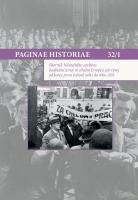Kultura radikální levice ve stínu politiky v dvacátých letech
Culture of the Radical Left in the Shadow of the 1920s Politics
Author(s): Marek KrejčíSubject(s): History, Cultural history, Recent History (1900 till today), Interwar Period (1920 - 1939), Historical revisionism
Published by: Národní archiv
Keywords: culture; radical left; Czechoslovakia 1918-1938
Summary/Abstract: The years after the First World War were marked by the growing political influence of the radical left; while many middle-generation artists (e.g. Josef Hora, S.K. Neumann) aligned with it, it was primarily comprised of radical youth. The subordination of the established network of proletarian culture organisations (Proletkult) to the agitation and propaganda department of the central committee of the Communist Party of Czechoslovakia symbolises the reflection of the subordinate position of art, most importantly understood as an agitation tool to affect the mass of workers. Through their agile political engagement, the representatives of leftist avant-garde art initially strove to enforce their right to artistic experiments against proletarian art. Over time, however, they had to confront, each in a different way, the principal contradiction between artistic individualism and freedom of creation on the one hand and rigid discipline and collectivism of the communist party on the other hand. The collective declaration of seven communist authors in February 1929 (Josef Hora, Marie Majerová, Helena Malířová, S.K. Neumann, Ivan Olbracht, Jaroslav Seifert, and Vladimír Vančura) received special publicity in the non-communist press. The previous attempts to criticise the growing party’s apparatus contingent of the Moscow headquarters (Karel Goliath), the renouncement of the democratic discussion principles (Karel Vaněk), and the communist adherents’ attempt to organise outside the party’s structures (Josef Bubník, Jan Skála) did not result in a wide response. In all cases, however, the critics were excluded from the party and ostracised as renegades and breakers of the workers’ movement, in which the party’s press especially played a sad role. Not only did the communist propaganda strengthen strong faith in a better future in the party’s members, symbolised by the idealised example of Soviet Russia, but it also influenced non-communist intellectuals. In the late 1920s, despite refuting democratic discussion principles among its members, the communist party relied on the support of non-communist intellectuals to pose as a thorough advocate of democratic principles against the right, as it is called, most importantly fascism and later Nazism, in the united Left Front project.
Journal: Paginae Historiae
- Issue Year: 32/2024
- Issue No: 1
- Page Range: 167-176
- Page Count: 10
- Language: Czech

